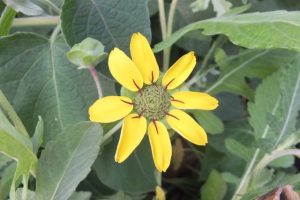In my last piece I described a greenhouse gem; the chocolate scented Cosmos, which I also noted was not exactly one of the neatest looking shrubs. Oddly, another powerfully chocolate scented flower, Berlandiera lyrata, also comes as an unruly small shrub.
There’s little obvious similarity in these even though they’re both in the family Asteraceae, save they both give off that wonderful aroma of vanilla milk chocolate from long stemmed blooms. The Chocolate Daisy is of the two the more powerfully scented and in full bloom can be found perfuming your greenhouse as if someone was brewing a cup of drinking cocoa there.

With golden daisy like flowers, green centres and crimson stamens over grey foliage this has the attributes of beauty, but a sparse and lax habit without support rather spoils the overall effect. Conveniently though the Chocolate Daisy seldom makes more than a foot or two in height and so can be buttressed amongst other stiffer subjects, or just allowed to flop. No matter, it is for the perfume you’ll want this wild flower from Texas.
Although the only species available commercially others were discovered native to the Southern United States and northern Mexico where they were named after the Belgian botanist Berlandier. This hot dry origin indicates the plants requirements and it may sulk in a drab UK summer though will recover when days are warmer.
Chocolate Daisies are easily grown from seed started in warmth in spring. The sowing needs be kept moist of course, but in a free draining compost, be very careful never to allow this to waterlog or the seedlings may rot. Although needing regular watering and feeding throughout summer the flowering plants must likewise never be allowed to stand in water. And in winter the compost needs to be closer to dry than moist, much like a succulent or cactus, not surprising when you’re native to Texas and New Mexico.

The flowers can be dead-headed, or taken for cutting, more will come, indeed in summer the whole plant can be pruned back for a new flush. On the other hand the blooms can be left to fade and the seed heads ripen as these are attractive in dried flower arrangements.


